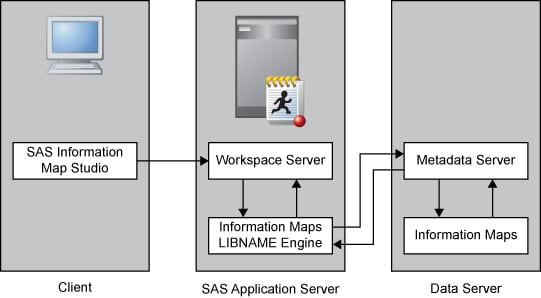Establishing Connectivity to a SAS Information Map
Overview of Establishing Connectivity to a SAS Information Map
A SAS Information Map
is a business metadata layer on top of another data source. When an
information map is registered as a table in a SAS Information Map
library, it can also be used as the data source for other information
maps. For more information about creating information maps, see either
the SAS Information Map Studio Help or Base
SAS Guide to Information Maps. Information map tables
are expected to be used primarily by SAS Information Map Studio.
-
Examine the final page of the wizard to ensure that the proper values have been entered. Click Finish to save the library settings. At this point, register tables as explained in Registering and Verifying Tables.
Special Considerations for Information Map Tables
-
When registering the tables with SAS Management Console, ensure that the check box for the option Enable special characters within DBMS object names option is selected. The New Library wizard uses data item IDs from the source information map as column names for the table. These data item IDs sometimes contain special characters.
-
By default, the values retrieved from an information map table are the detail values from the source information map. If you want to retrieve aggregated values, then you must set an aggregation option. You can set the AGGREGATE= options for tables and libraries in Data Library Manager in SAS Management Console. After you add a table as a data source for an information map, you can also set the aggregation option for the data source in the Table Properties dialog box in SAS Information Map Studio. Selecting the Use the detail values from the data source radio button is equivalent to setting the AGGREGATE= option to NO, and selecting the Use the aggregated values from the data source radio button is equivalent to setting the AGGREGATE= option to YES. This setting overrides the aggregation settings on the library or the table.
-
When referenced by an information map table, measure data items that reference other measure data items or that use aggregate functions in their expressions can produce aggregated values only. If a source information map contains one of these data items, then set the AGGREGATE= option to YES on the library. Otherwise, these data items are not registered as columns when you register the information map as a table.
-
If the source information map for an information map table has measure data items that reference other measure data items or that use aggregate functions in their expressions, then the combination of setting the AGGREGATE= option to YES on the library and setting the AGGREGATE= option to NO on the table or on the data source (within SAS Information Map Studio) causes the table data to be inaccessible.
-
Normally, when an information map table is registered, its columns get their formats from the associated source data items. However, when a source data item is a measure data item and has a data type of character, then if the AGGREGATE= option is set to NO on the library, the format is not set to the format of the source data item. The format is set to the format of the column that the source data item is based on.
